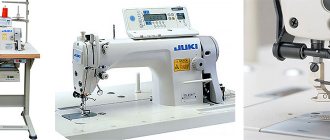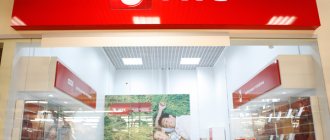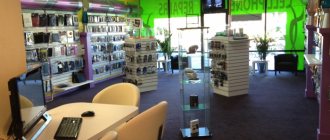One day, a company selling luxury household appliances approached us - it wanted to change its contextual advertising contractor. Communication with the previous one did not work out; in addition, there were complaints about the quality of the advertising campaigns themselves. The customer believed that the contractor was lacking initiative and offered few options for the development and optimization of advertising campaigns.
The main goal of our cooperation was to increase sales, and the peculiarity of the project was that the customer had a complex sales funnel, atypical for e-commerce.
Project specifics
The key difficulty of promotion was that Euroflett is not structured like a regular online store. The product cannot be purchased immediately by simply paying with a card online. If it is available in the store, the user receives a payment link by email. Before sending the link, a company representative must call the buyer to confirm the order.
Premium-class household appliances are expensive, and such a scheme is needed to eliminate customer losses if you have to return a paid order.
Hurry up to get a TOP profession in digital with a 50% discount!
- Learn SMM in practice - create your portfolio.
- Start earning money in 3 months.
- Get a diploma in SMM marketing and help in finding a job.
- Take advantage of installments up to 2 years without a down payment.
Read more
The sales funnel at Euroflett consists of the following stages.
1. Leads to the website (targeted calls, ordering callbacks, user contacts from an online consultant, application on the website). 2. The salesperson calls the client. 3. Registration of the transaction. 4. Sale.
This approach has a significant difficulty for the agency’s work - such logistics do not make it possible to control the entire path of converting leads into sales. You can only track the sources of users’ transitions to the store’s website and their targeted actions: calls, requests from the site, or calls to online chat.
In order to calculate the share of targeted requests in the total flow of incoming applications, store employees daily monitor dialogues in the online consultant and calls to the call center.
We could not find out what happens to the request after the company receives a lead: it is almost impossible to understand whether the person ultimately came to the store and whether he made a purchase. To do this, the client would need to specifically configure CRM on its side. Therefore, every month the customer sends us a report: what was sold and how much the buyer paid. This is useful but not complete information because we don't know where the user is coming from.
The customer understood that the final stage of sales takes place entirely on his side and depends only on him, so the agency was given the task of increasing the number of leads and reducing their cost per unit.
However, although formally we were only responsible for leads, when setting up advertising campaigns, we still thought about the final sales.
How to open a business from scratch selling small household appliances?
But you should know that trading in this group of products involves certain risks. The most important of them is the high level of competition in the industry. Another important aspect is the considerable financial costs of purchasing goods.
On video: Sales techniques in a retail store
Small household appliances traditionally include products for the kitchen, home, health and beauty.
The assortment of a small household appliance store usually includes the following:
- multicookers;
- blenders;
- meat grinders;
- Food processors;
- microwaves;
- vacuum cleaners;
- irons;
- sewing machines;
- scales;
- hair dryers and other electrical goods.
On video: How to sell using the “Pie” technique
Opening a business selling small household appliances is profitable, since kitchen and home goods, which make up the majority of the assortment of such stores, make people’s lives much easier, and in addition, small household appliances are in high demand even in times of crisis.
Another advantage of selling small household appliances is that customers willingly buy such goods in online stores. Therefore, to reduce start-up investments, you can first open an online store and only then, when the enterprise begins to generate stable income, switch to the format of a standard retail outlet.
Thus, before starting a business, it is very important to draw up a business plan in which to analyze competitive companies in the chosen industry, taking into account demand and current offers, think over a specific assortment and pricing policy, and also determine whether the store will have a regular retail format points or will start working on the Internet. In the business plan, the necessary financial investments must be calculated and a forecast of the profitability of the future company made.
On video: Assortment and display of goods in an Australian hardware store
When drawing up a business plan, you should calculate each point of the organization of the future enterprise separately. Despite the fact that investments in starting a business may differ in certain details, as practice shows, on average, before starting a business from scratch selling small household appliances, you need to invest at least 500 thousand rubles.
It makes sense to open an online store primarily for those entrepreneurs who do not have sufficient start-up capital to establish a stationary store. In this case, you do not need to pay rent for premises, purchase commercial equipment, spend money on utilities, security, in addition, you can purchase a minimum amount of goods and hire only one assistant. However, it should be remembered that the average buyer trusts online stores less, and therefore, in order to attract a sufficient number of customers, you will have to resort to various promotions and discounts, as well as pay attention to advertising.
Optimized the advertising campaign
We started work by improving the customer's existing advertising campaigns.
The first thing the client wanted to optimize was the type of advertisement. It was necessary to make sure that users who are looking for a specific model of equipment see its name in advertisements. For example, if a person is looking for a certain brand of hood, then the name of this particular model would be shown in the contextual ad:
We have eliminated obvious errors in advertising settings. We changed the general heading that was in all advertisements. We expanded the list of useful keywords - not all possible keywords were optimally selected in the previous campaign.
Then we took on more complex tasks. The client was concerned about the problem of ineffective spending of advertising budgets. For example, if a certain model was not on the site, its advertising still continued to run. It was necessary to link the content of the advertisement with the actual availability of the product on the site. The client wanted to turn off advertising for such products, but it is impossible to do this manually - there are more than 5 thousand different models on the site.
The inverse problem was also relevant: if new models appeared on the site, they did not automatically appear in advertising campaigns.
In addition, it was necessary to add a price to the ad - if the user immediately understands how much the advertised product costs, this increases conversion. Here the task was to automatically display the current price in ads if it changed for a product on the website.
Set up model campaigns using K50
We discovered that Euroflett had created but not activated an account in the K50 contextual advertising automation service. We decided to set up this tool and use it in further work to optimize advertising campaigns and ads.
The customer's profile included brand and model advertising campaigns. The first ones brought the most leads, but were made with a lot of mistakes. In addition, they lacked keywords. For example, Latin brand names were not duplicated in Russian. The customer entered keywords manually and therefore lost some traffic.
It was also important that model campaigns must include a price. Therefore, we were faced with a global task - to completely change the structure of model campaigns.
1. To increase conversion, we changed the content of advertisements. Ads in new campaigns must have:
- in heading 1 - the names of the category, brand and model. For example, Asko DFI433B dishwasher;
- in heading 2 - the current price for the model.
If the price changes on the site, then it should automatically change in the header.
2. We formed a keyword pool for each model.
People search for the necessary models in different ways: some enter the name in the search engine in Latin, and others in Russian. Therefore, in advertisements, the brand name must be in both Latin and Cyrillic alphabet. Example: Asko DFI433B, Asko dfi433b.
3. All new models that appear in the site catalog should be automatically added to the advertising campaign.
4. If a model’s status on the website changes from “In stock” to “On order,” then her advertising must be stopped.
Difficulties in setting up
The scripts for automatically generating ads in K50 were complex, and sometimes the keys were not generated correctly.
The difficulty of this work was that these rules cannot be made universal for all models. For example, if the product description also contains a color, then a failure occurs. Therefore, sometimes you have to semi-manually modify templates, and sometimes ask developers from K50 to carry out custom modifications.
Problems we faced
1. The current keyword template needs to be improved as it does not take typos and slang into account.
For example, users are looking not only for washing machines, but also for washing machines. For the Mitsubishi brand, only transliteration is not suitable, since users search for the brand in different ways - Mitsubishi, Mitsubishi, Mitsubishi, Mitsubishi and so on.
In order for us to have keywords with typos and slang, we need to create a list of synonyms. To do this, go to “General Settings”.
We select synonyms and create the necessary lists. For example, a list of brands, which will include all brands in different spellings. Click "Bulk Editing". We come up with a name for the list and, separated by commas, as in the example, set all the brands and their spelling, save.
Example:
Now you need to change the phrase template and add the “Synonyms” function to the #vendor# tag, specify the name of the list with synonyms in Argument 1, and “entirely” in Argument 2:
2. The feed included models that had a color in their name.
Example: “Hood Maunfeld MZR 60 Black.” As a result, based on a given phrase template, K50 generated keywords of the following type:
- Maunfeld MZR 60 Black;
- Maunfeld MZR 60 Black.
Such keywords were not suitable for us, as they greatly reduced traffic. Most users simply type in Maunfeld MZR 60 without specifying a color.
Again we had to modify the phrase template.
3. Sometimes there were symbols in the model name.
For example, “Hob Ilve H31/ I”. We got keywords something like this:
- Ilve H31 I;
- Ilwe H31 I.
By analogy with the previous example, here it was necessary to modify the template. Since such a set of keys narrows the traffic.
4. Not all users enter the name of the brand and model into the search bar.
Some already know what they need and simply type in a model without a brand. For example, instead of Miele CS 1011, they enter the query CS 1011. In this case, they are shown general advertising for the Miele brand, but for such a narrow query, the user wants to show more relevant advertising - with the model that the user is looking for.
Again I had to modify the phrase template.
How to open a business from scratch selling small household appliances: official registration
A business will only be legal and permitted by law if it is officially registered with the tax office. Small household appliances can be sold both by legal entities (often this is an LLC form) and individual entrepreneurs. It is important to immediately understand the difference between these organizational forms in order to choose the most suitable one.
The status of an individual entrepreneur is suitable for opening a small retail outlet offering customers a limited range of goods, or an online store. In this case, the registration process will be faster and simpler. It is necessary to fill out a special application form, indicating the personal data of the entrepreneur and the specifics of the store’s activities. In particular, when trading via the Internet, you can additionally specify the code “Retail trade by mail or via the Internet information and communication network,” which gives the right to make sales online. Having prepared copies of the passport and identification number, as well as having paid the state fee and provided a copy of payment, the future entrepreneur can submit an application, accompanied by a package of documents, to the Federal Tax Service. The applicant receives the IP certificate 5 working days after submitting the application.
If the business founder plans to open a large store or even a chain of retail outlets, the only suitable registration option will be the LLC form. In addition to the application for registration, payment of the fee and copies of personal documents of each of the future founders, upon registration you need to draw up the charter of the future enterprise, a decision on the establishment of an LLC and contribute the authorized capital, the amount of which must be at least 10 thousand rubles. The requirements for applicants when registering an LLC are higher; therefore, submitted documents are reviewed within 14 working days.
In general, the question of how to open a business selling small household appliances is simple. All actions of the company’s founders must be subject to strict planning, taking into account existing trends in the chosen area of business activity.
Conducted segmentation of brands by margin
After the initial setup and automation of the customer’s advertising campaigns, we began to look for opportunities to further optimize our work. The store had different conditions for working with brands.
We decided that it was possible to segment all equipment suppliers by margin and rebuild advertising campaigns accordingly - paying more attention to higher-margin brands.
The customer provided us with data on the margins of each supplier. Next, we changed the naming of campaigns to make it easier to track marginal brands. Previously, campaigns had this naming:
Brand/Asko/SE/MSK/desk_mob/0/0/0 Brand/Hitachi/SE/MSK/desk_mob/0/0/0
There was no priority in the naming of the campaigns.
All brands were divided into low-margin, medium-margin and high-margin brands.
Each category was assigned a numerical designation. Happened:
- brands with high margins (1);
- medium-margin brands (2);
- low-margin brands (3).
Next, each brand received an additional numerical designation, arbitrary (started with 10). That is, a catalog with brands appeared:
10. Asko 11. Miele 12. V-Zug 13. Bosch 14. Hitachi
We then combined the number from the catalog with the brand category and added it to the campaign title. We get a new naming:
10.1/Brand/Asko/SE/MSK/desk_mob/0/0/0 14.2/Brand/Hitachi/SE/MSK/desk_mob/0/0/0
This naming allows you to quickly filter all campaigns by brand (for example, Hitachi is number 14), as well as filter by margin - all marginal brands have 1 in the campaign name.
In this form, it has become easier to summarize statistics on brands. Having studied the data over recent months, we found that 45% of the budget is spent on low-margin brands and the share of the budget for them is growing every month.
Of course, this is beneficial for the agency, since these brands have a large traffic capacity, and the cost per lead is lower than in brands with medium and high margins. We met our KPIs for the volume of leads and their cost.
However, in this case the client receives more leads, but they do not pay off. Therefore, we decided to change the logic of budget distribution: we turned off all low-margin brands, and redistributed the budget to brands with medium and high margins. At first, due to the exclusion of low-margin brands, there was a drawdown in the volume of leads, but after some time everything recovered.
As a result, sales volume remained the same, but net revenue increased due to marginal brands.
How to open a business: organizational aspects
Selling small household appliances as a business
Before starting a business from scratch selling small household appliances, you need to choose a suitable premises for the store, the size of which can range from 100 to 200 sq.m. depending on the quantity of assortment presented in it. It is advisable to distribute the premises so that the sales area occupies up to 85–90% of the total space. The remaining 10-15% of the territory can accommodate a warehouse for products and utility rooms for employees. The warehouse must be dry and well ventilated, since household appliances are very sensitive to storage conditions.
The best location for a small household appliances store will be the city center or one of the prestigious residential areas: that is where the largest target audience with a high level of solvency will be. According to the calculations of experienced entrepreneurs, the monthly income of a store in a residential area will be from 20 to 30 thousand dollars, while in central areas this figure increases on average to 45 thousand dollars. It is advisable to equip a parking lot near the store; a noticeable sign is required, which will become one of the most important methods of attracting customers.
All store products can be placed on separate shelves and racks. At the same time, you don’t have to divide the sales area into separate sectors, simply making several zones that flow into one another, in which goods of different categories will be placed. The placement of the assortment must be carried out according to the basic rules of merchandising, so it is advisable to train employees in these standards or seek the help of an invited specialist.
As for the renovation of the premises, this item should definitely be included in the business plan: depending on the initial condition of the premises, the cost of repair work can range from $200 to $600. This cost item will largely depend on the level of the store, so you should decide at the very beginning whether the outlet will be a premium or economy class enterprise.
Small household appliances: how to start a business from scratch
In the process of preparing the premises for opening a store, it is necessary to obtain permits from special regulatory services. First of all, these will include fire and sanitary services. You should familiarize yourself in advance with the norms of the society on consumer protection and the department for combating economic crime. It is imperative to equip the premises with a fire alarm; installing a security system may be equally important.
The number of employees should depend on the volume of the store’s assortment. As a rule, an average store should have 2-3 sales assistants on shift. If the outlet is small, there may be only 1-2 sellers on shift. The education, age and work experience of sellers will be unimportant - they require knowledge of the technical characteristics of all products and the presence of skills necessary for successful sales. Technical personnel will also be needed to clean the premises. If customers are offered a home delivery service, they will need to purchase a company car and hire a driver.










